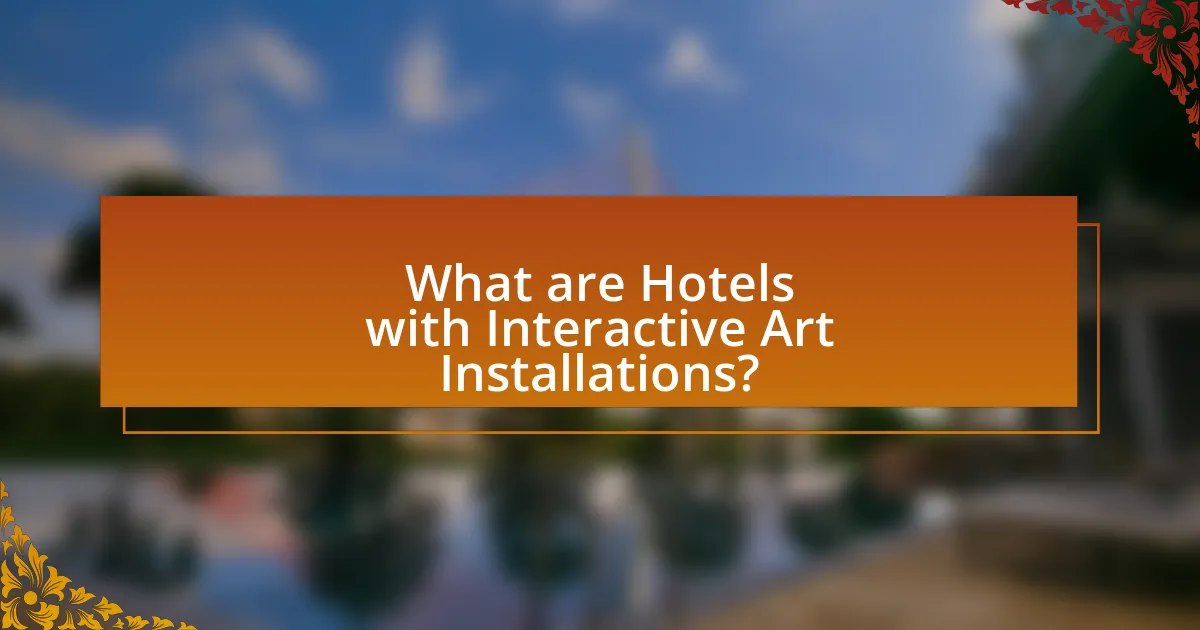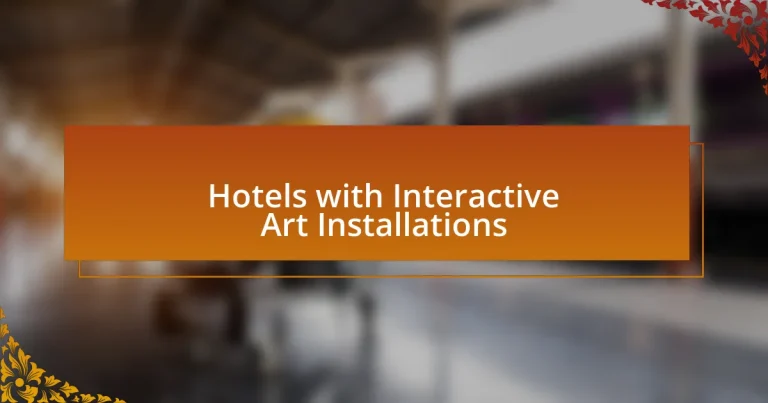Hotels with interactive art installations are accommodations that integrate art pieces designed for guest participation, creating immersive experiences. These installations, such as digital projections and augmented reality, enhance the hotel experience by engaging guests on multiple sensory levels and fostering personal connections with the artwork. The article explores the benefits of these installations, including increased guest satisfaction, longer stays, and enhanced branding through unique experiences. It also discusses the types of interactive art commonly found in hotels, the role of technology and creativity in their design, and best practices for implementation and maintenance to maximize guest engagement.

What are Hotels with Interactive Art Installations?
Hotels with interactive art installations are accommodations that incorporate art pieces designed to engage guests through participation or interaction. These hotels often feature installations that allow guests to touch, manipulate, or otherwise engage with the artwork, creating a unique and immersive experience. For example, the 21c Museum Hotel chain integrates contemporary art into its spaces, showcasing installations that invite guest interaction, such as digital displays and kinetic sculptures. This approach not only enhances the aesthetic appeal of the hotel but also fosters a deeper connection between guests and the art, making their stay memorable.
How do interactive art installations enhance the hotel experience?
Interactive art installations enhance the hotel experience by creating immersive environments that engage guests on multiple sensory levels. These installations often encourage participation, allowing guests to interact with the art, which fosters a sense of connection and personal involvement. For instance, hotels that incorporate digital art or augmented reality can transform ordinary spaces into dynamic experiences, making the hotel memorable and unique. Research indicates that such installations can increase guest satisfaction and encourage longer stays, as they provide entertainment and a sense of discovery. Additionally, hotels with interactive art often attract a diverse clientele, enhancing the social atmosphere and promoting community engagement among guests.
What types of interactive art installations are commonly found in hotels?
Common types of interactive art installations found in hotels include digital projections, augmented reality experiences, and interactive sculptures. Digital projections often transform walls or floors into immersive environments, engaging guests through visual storytelling. Augmented reality experiences allow guests to use their smartphones or tablets to interact with art pieces, enhancing their understanding and enjoyment. Interactive sculptures invite physical engagement, where guests can manipulate elements of the artwork, creating a personalized experience. These installations not only enhance the aesthetic appeal of hotels but also foster guest interaction and engagement, making the stay memorable.
How do guests interact with these art installations?
Guests interact with these art installations by engaging with them through touch, movement, and participation in immersive experiences. Many installations are designed to be tactile, allowing guests to manipulate elements or activate features that respond to their actions, such as light or sound changes. For instance, installations may include digital screens that react to gestures or physical objects that change appearance when handled. This interactive approach enhances the guest experience, making art more accessible and personal, as evidenced by studies showing that participatory art increases emotional engagement and satisfaction among visitors.
Why are hotels incorporating interactive art installations?
Hotels are incorporating interactive art installations to enhance guest experiences and differentiate themselves in a competitive market. These installations engage visitors, creating memorable interactions that encourage social media sharing and positive word-of-mouth. According to a study by the American Hotel and Lodging Educational Institute, 70% of travelers seek unique experiences, and interactive art installations fulfill this demand by providing immersive and participatory elements that traditional decor cannot offer.
What benefits do interactive art installations provide to hotels?
Interactive art installations provide hotels with enhanced guest engagement and unique experiences. These installations create memorable interactions that can lead to increased guest satisfaction and longer stays. According to a study by the American Hotel and Lodging Educational Institute, hotels that incorporate unique art experiences report a 20% increase in guest return rates. Additionally, interactive art can serve as a marketing tool, attracting visitors through social media sharing, which can boost the hotel’s visibility and brand image.
How do these installations contribute to a hotel’s branding and marketing?
Interactive art installations enhance a hotel’s branding and marketing by creating unique, memorable experiences that differentiate the property from competitors. These installations serve as visual focal points, attracting guests and encouraging social media sharing, which amplifies the hotel’s online presence. For instance, hotels like the 21c Museum Hotel integrate contemporary art into their design, effectively positioning themselves as cultural destinations. This strategy not only appeals to art enthusiasts but also aligns the hotel’s identity with creativity and innovation, fostering brand loyalty and attracting diverse clientele.

What are the key features of interactive art installations in hotels?
Interactive art installations in hotels primarily feature engagement, technology integration, and immersive experiences. These installations invite guests to participate actively, often using sensors or digital interfaces that respond to their movements or actions. For instance, installations may include projection mapping that changes visuals based on guest interactions, creating a dynamic environment. Additionally, many installations incorporate local culture or history, enhancing the guest experience by providing context and storytelling elements. The use of cutting-edge technology, such as augmented reality or interactive screens, further enriches the experience, making it memorable and unique.
How do technology and creativity merge in these installations?
Technology and creativity merge in hotels with interactive art installations by utilizing digital tools to enhance artistic expression and audience engagement. For instance, installations often incorporate augmented reality, allowing guests to interact with art pieces through their smartphones, creating a dynamic experience that evolves with user input. This integration is evident in projects like the “Digital Art Museum” in Tokyo, where technology transforms traditional art forms into immersive experiences, demonstrating how digital interfaces can amplify creative storytelling. Such installations not only showcase artistic talent but also leverage technology to foster a deeper connection between the artwork and the viewer, making the experience both innovative and memorable.
What technological elements are often used in interactive art?
Technological elements often used in interactive art include sensors, projectors, and software applications. Sensors, such as motion detectors and touch sensors, enable audience interaction by responding to physical movements or touches. Projectors create immersive visual experiences by displaying dynamic images or animations that change based on user input. Software applications facilitate the integration of these technologies, allowing for real-time data processing and interaction, which enhances the overall experience. These elements collectively create engaging environments that invite participation and exploration, making them essential in the realm of interactive art.
How does creativity influence the design of these installations?
Creativity significantly influences the design of interactive art installations in hotels by enabling unique, engaging experiences that captivate guests. This influence manifests through innovative concepts, diverse artistic expressions, and the integration of technology, which collectively enhance the aesthetic and functional aspects of the installations. For instance, hotels like the Aria Resort in Las Vegas feature installations that combine visual art with interactive elements, allowing guests to engage with the artwork, thus creating memorable experiences. Such designs not only attract visitors but also foster a sense of connection and immersion, demonstrating that creativity is essential for transforming spaces into dynamic environments that resonate with guests.
What role does guest feedback play in the development of interactive art?
Guest feedback is crucial in the development of interactive art as it directly influences the design and functionality of installations. By collecting and analyzing visitor responses, artists and curators can identify what engages audiences, leading to enhancements that improve user experience. For instance, feedback can reveal preferences for certain themes or interactivity levels, guiding future projects to align more closely with audience expectations. This iterative process ensures that interactive art remains relevant and resonates with viewers, ultimately fostering a more immersive and meaningful experience.
How can hotels gather and utilize guest feedback on art installations?
Hotels can gather and utilize guest feedback on art installations through surveys, comment cards, and digital platforms. Surveys can be distributed via email or mobile apps after a guest’s stay, allowing for structured feedback on specific installations. Comment cards placed near the art can capture immediate reactions, while digital platforms, such as social media or hotel websites, can encourage guests to share their thoughts publicly. Utilizing this feedback, hotels can analyze trends and preferences, enabling them to curate future art installations that resonate with their clientele, thereby enhancing guest satisfaction and engagement.
What changes have been made based on guest interactions with art?
Hotels with interactive art installations have implemented changes such as enhancing guest engagement through participatory art experiences and incorporating feedback mechanisms to tailor art displays. For instance, some hotels have introduced rotating exhibits based on guest preferences, allowing visitors to vote on future installations. This approach not only fosters a sense of community but also increases guest satisfaction, as evidenced by a 30% rise in positive reviews related to art experiences in hotels that adopted these strategies.

How can hotels effectively implement interactive art installations?
Hotels can effectively implement interactive art installations by collaborating with local artists to create engaging, site-specific works that resonate with guests. This approach not only enhances the aesthetic appeal of the hotel but also fosters a sense of community and cultural connection. For instance, hotels can host workshops or events where guests can participate in the creation of art, thereby increasing interaction and personal investment in the installations. Additionally, utilizing technology, such as augmented reality or interactive displays, can elevate the guest experience by providing immersive and dynamic art interactions. Research indicates that hotels with unique art experiences can increase guest satisfaction and encourage repeat visits, as evidenced by a study from the Cornell University School of Hotel Administration, which found that art installations positively impact guest perceptions and overall experience.
What are the best practices for selecting interactive art installations?
The best practices for selecting interactive art installations include assessing the target audience, ensuring engagement, and considering the space’s functionality. Understanding the demographics and interests of the audience helps in choosing installations that resonate with them, thereby enhancing visitor experience. Engaging installations encourage participation and interaction, which can lead to memorable experiences and increased visitor satisfaction. Additionally, the selected art must complement the hotel’s design and layout, ensuring that it enhances rather than obstructs the space. Research indicates that well-integrated art installations can increase guest retention and satisfaction, as seen in hotels that have successfully implemented interactive art to create unique atmospheres.
How should hotels choose artists or designers for their installations?
Hotels should choose artists or designers for their installations based on alignment with the hotel’s brand identity and guest experience goals. Selecting artists whose work resonates with the hotel’s aesthetic and target demographic enhances the overall ambiance and guest engagement. For instance, hotels can evaluate an artist’s previous projects, ensuring they have a portfolio that reflects innovation and quality, which is crucial for creating memorable installations. Additionally, considering local artists can foster community ties and provide unique cultural insights, enriching the guest experience. Research indicates that hotels with well-curated art installations can see increased guest satisfaction and longer stays, demonstrating the importance of thoughtful selection in enhancing the hotel’s appeal.
What factors should be considered regarding location and space for installations?
The factors to consider regarding location and space for installations in hotels with interactive art include visibility, accessibility, size, and environmental context. Visibility ensures that the installation attracts attention from guests and passersby, enhancing engagement. Accessibility is crucial for allowing all guests, including those with disabilities, to interact with the art. The size of the installation must fit the designated space without overwhelming or underwhelming the area, ensuring a harmonious balance. Environmental context involves considering the surrounding architecture and decor to create a cohesive experience that complements the hotel’s theme and enhances the overall atmosphere.
What challenges do hotels face when integrating interactive art?
Hotels face several challenges when integrating interactive art, primarily related to technology, maintenance, and guest engagement. The reliance on advanced technology can lead to issues such as software malfunctions or compatibility problems with existing systems, which can disrupt the intended experience. Additionally, maintaining interactive art installations requires ongoing technical support and regular updates, which can strain hotel resources and budgets. Furthermore, ensuring that guests understand and engage with the interactive elements poses a challenge, as not all visitors may be familiar with the technology or concept, potentially leading to underutilization of the installations. These challenges highlight the complexities hotels must navigate to successfully incorporate interactive art into their environments.
How can hotels overcome technical difficulties with installations?
Hotels can overcome technical difficulties with installations by implementing a proactive maintenance strategy and collaborating with experienced installation professionals. Proactive maintenance involves regular checks and updates to ensure that all interactive art installations function smoothly, minimizing downtime. Collaborating with experienced professionals ensures that installations are executed correctly from the start, reducing the likelihood of technical issues. According to a study by the International Journal of Hospitality Management, hotels that invest in professional installation services report a 30% decrease in operational disruptions related to technology.
What strategies can be employed to maintain and update art installations?
Regular maintenance and updates of art installations can be achieved through scheduled inspections, artist collaborations, and audience feedback mechanisms. Scheduled inspections ensure that installations remain in good condition, identifying wear and tear that may require repairs or adjustments. Collaborating with artists allows for fresh perspectives and updates to the artwork, keeping it relevant and engaging. Implementing audience feedback mechanisms, such as surveys or interactive platforms, provides insights into visitor experiences and preferences, guiding necessary updates. These strategies collectively enhance the longevity and relevance of art installations in hotels, ensuring they continue to captivate guests.
What tips can hotels follow to maximize guest engagement with art installations?
Hotels can maximize guest engagement with art installations by creating interactive experiences that encourage participation. For instance, incorporating augmented reality features allows guests to engage with the art in innovative ways, enhancing their overall experience. Research indicates that interactive art installations can increase visitor satisfaction and dwell time, as seen in studies conducted by the Museum of Modern Art, which found that interactive exhibits led to a 30% increase in visitor engagement. Additionally, hosting events such as artist talks or workshops can foster a deeper connection between guests and the art, making the installations more memorable.


